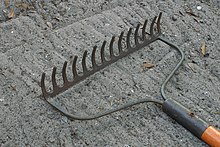Rake (tool)
As rake is known especially in the northern and central Germany language area compared to rake a hand tool with an even shorter stem (rake: about 2 m) and a transverse thereto for the next metal part as a bar for the tines which generally manufactured in one piece and carries the prongs arranged at right angles to the base . Due to the design and use, there are flowing transitions to arithmetic, which is one of the reasons for the sometimes synonymous use of the terms.
It is used, for example, to sweep up grass clippings or garden waste such as leaves.
Type and use
The rake is mostly made of wood and metal. So-called spring brush , leaf rake , leaf rake , Sweep or fan rakes have different structures and are primarily suitable for sweeping up of leaves. A fan-like construction, which is often adjustable in width, in connection with the spring-loaded tines enables the user to work on the ground with a comparatively high amount of pressure. The spring broom hardly ever gets stuck because its, usually quite wide, tin prongs are pulled across the floor at a comparatively flat angle. Small-toothed metal rakes are more suitable for working on well-tended lawns , as they can also pick up small parts and scarify the lawn at the same time .
In addition, metal rakes were used in iron processing in the 19th century to move charcoal or coke to the optimal place on the grate.
literature
- Christian Reichart: Land and Garden Treasure, Volume 2, 1819, p. 67f
Individual evidence
- ↑ Rhea Kyvelos (ed.): Variant Dictionary of German, 2004, p. 332
- ↑ J. Wakefield: About improvements in the construction of furnaces for boilers. In: Polytechnisches Journal . 8, 1830, pp. 304-314.
- ↑ Stephan von Keess, W. Blumenbach: Systematic presentation of the latest advances in trades and manufactories, Volume 2, p. 122
